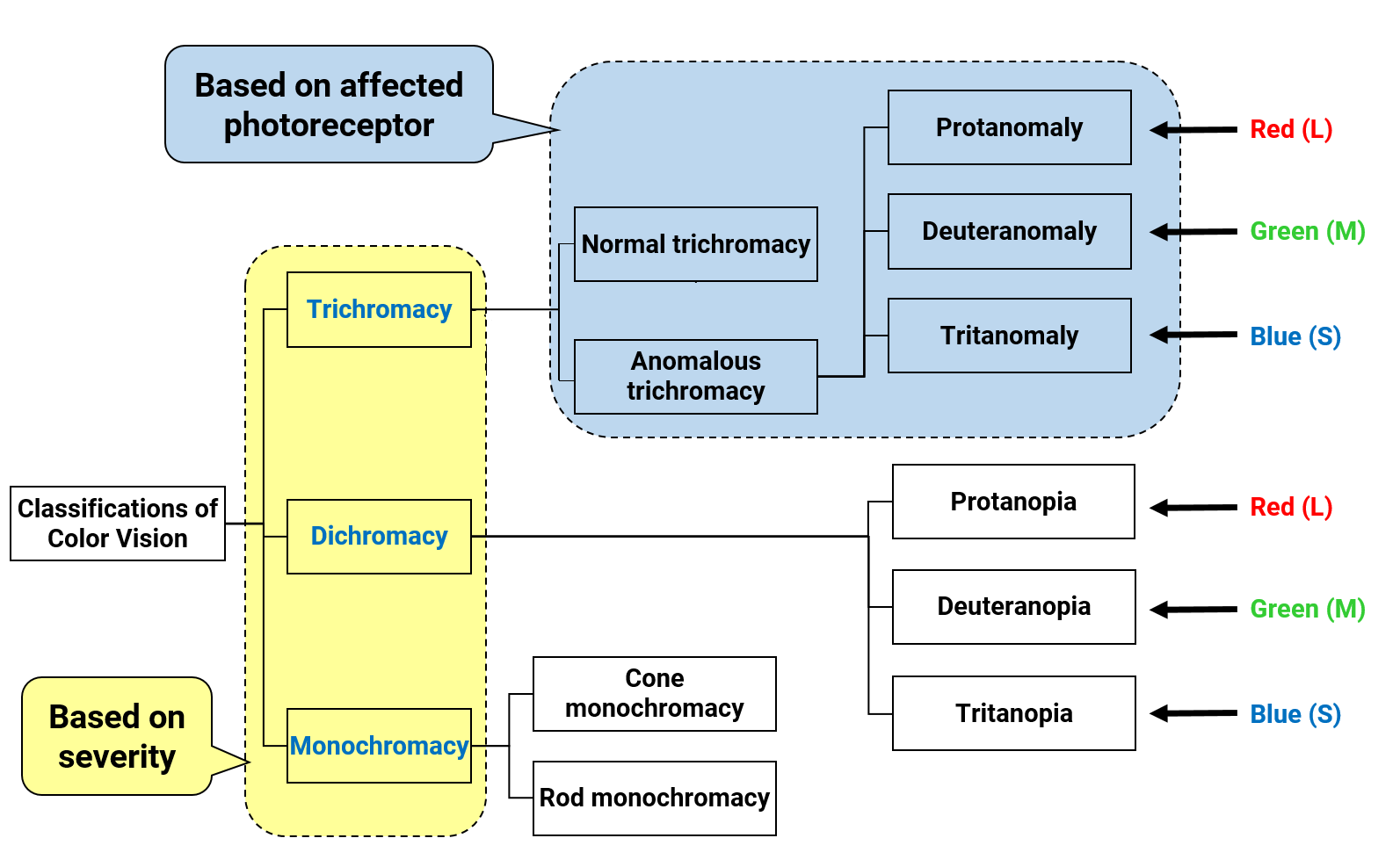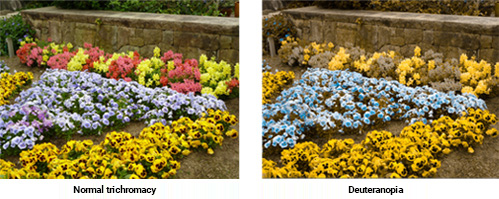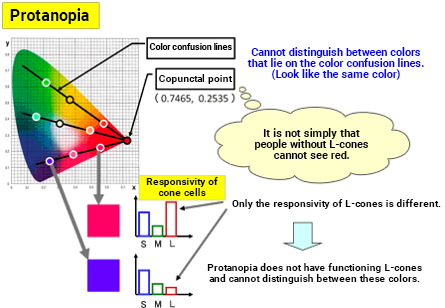Theory of Light and Color

14. Sense of Sight and Color (Part 2)
Individual Differences in Color Vision and Color Blindness
The differences in color sense between individuals affect color perception. These differences can be indistinct in normal color vision and thus hard to recognize. Understanding the types of color blindness illustrates how much color sense can vary.
Individual Differences in Color Vision and Color Blindness
The brain recognizes colors color because light stimulates the photoreceptors (cone cells). The L-, M- and S-cone cells have a high sensitivity in the long-, middle-, and short-wavelength bands, respectively.
There are negligible differences in sensitivity from person to person but not to the extent that causes problems in daily life. However, these differences are more pronounced in color blindness.

Classifications of Color Vision
Color blindness is divided into trichromacy, dichromacy, and monochromacy. It is further divided into three classifications depending on which photoreceptors cause color blindness. Type 1, type 2, and type 3 correspond to abnormal or missing L-cones, M-cones, and sensor-metric, respectively.

Trichromacy
Normal trichromatism is when all three types of cone cells are present and functioning normally. However, color blindness can still occur if the sensitivity in one of the three types of cone cells is low or otherwise abnormal. For instance, deuteranomaly refers to reduced sensitivity in the M-cones (green light).
Dichromacy
Any one of the L-, M-, or S-cones is not present, leaving the remaining two types to recognize colors.
Monochromacy
Any two of the three types are missing. Monochromacy also describes the condition where no cone cells are present, but the rod cells are still functioning. Rod cells cannot recognize colors, only brightness.
The below images give an impression of how a scene looks to color-blind vision compared to normal color vision, though it is not an actual representation. This example simulates deuteranopia. ≪1≫

Dichromat Color Confusion
Dichromats can see color but experience color confusion, where they cannot recognize certain color combinations because they see a narrower range of color.
The xy chromaticity diagram can illustrate which colors are confused by color-blind vision. ≪2≫ There is a copunctal point for each of the three types of dichromat color blindness. Color-blind people cannot distinguish between colors that lie on the color confusion lines intersecting the copunctal point. There are only three color confusion lines in each example below, but in reality, all lines converging on the copunctal point are color confusion lines.
Protanopia
There are no functioning L-cones, so protanopes experience red-blindness. The responsivity of M- and S-cones to colors on the same color confusion line are unchanged.

Deuteranopia
There are no functioning M-cones, so deuteranopes experience green-blindness. The responsivity of L- and S-cones to colors on the same color confusion line are unchanged.

Tritanopia
There are no functioning S-cones, so tritanopes experience blue-blindness. The responsivity of L- and M-cones to colors on the same color confusion line are unchanged.

Color blindness is an extreme example of how an individual's color sense can change color perception. While it is a condition unique to human vision, machine vision also has different sensitivity properties of the camera.
Different sensitivities in image sensors are similar to individual differences in human photoreceptors (cone cells). The spectral sensitivity of image sensors often differs depending on camera manufacturers and models. Moreover, cameras of the same model can have slightly different sensitivity properties. The sensors change the resulting image even under the same light source.
Comment
≪1≫
This example is from the color vision simulation software made by TOYO INK CO., LTD.
≪2≫
The CIE xy chromaticity diagram is a color coordinate system constructed by the theory of additive color mixing. The color information corresponding to all hues and chromatic values recognized by the standard colorimetric observer correlates to numerical coordinates (x, y) within the horseshoe area.
Sense of Sight and Color (Part 2)
Individual Differences in Color Vision and Color Blindness

